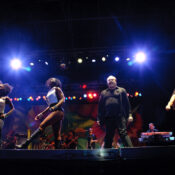Every artist and athlete aspires to greatness and envisions a dream scenario for how their careers will end. So while “saving the best for last” and “going out on top” may seem like clichés, that’s how The Police actually did it in 1983. Amid external pressures and internal tension, Sting, Stewart Copeland, and Andy Summers released Synchronicity, their fifth and final album as a group. At that moment, they were the biggest band in the world, and that record proved why.
English bassist/vocalist Sting and American drummer Stewart Copeland had met in 1976 and got together to jam for the first time the following January. After forming The Police in 1977 with Corsican guitarist Henry Padovani, the band began playing that March. Sting and Copeland met English guitarist Andy Summers while collaborating with another group. Summers joined The Police, and by that summer, Padovani was out. The Police would remain a trio for the rest of their existence.
“Roxanne” (Uploaded to YouTube by The Police)
Stylistically, the early Police sound came from punk, but incorporated wider influences like reggae, progressive rock, and even jazz. This made them outliers in the broader punk movement. Strangely enough, the band agreed in their early days to do a chewing gum commercial (directed by future Top Gun helmer Tony Scott) for which they all went bleach-blonde. The ad never aired, but the hair became a trademark look for the young group.
The band took on Copeland’s older brother, Miles, as their manager in 1978, and entered the studio to record their first album, Outlandos d’Amour, before they’d even signed a deal to release it. Miles wasn’t wild about most of the tracks, but reacted enthusiastically to one song in particular: “Roxanne.” He used it to sell A&M Records on the band. When the BBC refused to add the new single to their playlist because of its frank discussion of prostitution, the label promoted “Roxanne” as “Banned by the BBC.” The suggestion of forbidden fruit helped the song take off in the U.K.
“Don’t Stand So Close to Me” (Uploaded to YouTube by The Police)
As the group began stringing together a portfolio of U.K. hits, they started touring the U.S. Though there were no hit singles for a while, their second album, Reggatta de Blanc, made it to #25 in the States on the back of their constant touring. By March of 1980, The Police started touring countries in Asia and Africa, a strategy that would eventually build the group into a global success. The band recorded Zenyatta Mondatta, which would yield their first two Top 10 hits in the States (“Don’t Stand So Close to Me” and “De Do Do Do, De Da Da Da”) as well as two Grammys (Rock Vocal Performance for Duo or Group for “Don’t Stand” and Best Rock Instrumental Performance for “Behind My Camel.”) Those songs, coupled with music videos and the arrival of MTV in 1981, would dramatically increase the band’s American profile.
“Every Little Thing She Does Is Magic” (Uploaded to YouTube by The Police)
The Police only got bigger with 1981’s Ghost in the Machine. “Every Little Thing She Does Is Magic” was a U.S. #3, and both it and “Spirits in the Material World” were global hits. Over the next couple of years, the familiar problems of successful rock bands began to set in. Sting and Summers would both split from their wives. Sting began accepting acting roles, and all three musicians would do side projects and soundtrack work. The singer made worldwide news when he accepted the high-profile role of Feyd-Rautha in maverick filmmaker David Lynch’s adaptation of Frank Herbert’s novel Dune. Sting’s fame and ongoing arguments about the musical direction of the band escalated tensions in the trio, particularly among Sting and Copeland, who frequently argued about the music. It was during this tempest that the band would record their masterpiece.
“Synchronicity II” (Uploaded to YouTube by The Police)
Recording for Synchronicity began in December of 1982. The album’s name and many concepts that are woven through the record were attributed to the book The Roots of Coincidence by Arthur Koestler. The band’s previous album, Ghost in the Machine, was actually named for one of Koestler’s books. Roots dealt with parapsychology and included much discussion of psychologist Carl Jung’s notion of “synchronicity,” wherein things can appear to be related without reason, but actually have connected meaning for the individual.
If you wanted to look for a metaphor for how the band was getting along, you found it in the recording process. Though it was primarily deployed for sound reasons, the band played the tracks together live, but each from a separate room. After playing a song a few times with variations and changes, the band would convene with producer Hugh Padgham and edit together the parts that they liked best. During the recording “Every Breath You Take,” the enmity between Copeland and Sting finally exploded; though verbal altercations were common in the band, the pair clashed physically. In the Sound on Sound article on the making of the song, Padgham said, “…they were sick of each other — Sting and Stewart hated each other, and although Andy didn’t show as much venom, he could be quite grumpy — and there were both verbal and physical fights in the studio.” A good deal of the arguing centered on Sting trying to tell Copeland, who was universally recognized as a world-class drummer, exactly what to play on the track instead of allowing Copeland’s normal contribution to the composition. The battles were so bad that Padgham called in Miles to mediate; Padgham attributes a poolside conference led by Miles to actually saving the entire album, as the band were extremely close to walking away.
“Wrapped Around Your Finger” (Uploaded to YouTube by The Police)
But, if the history of rock has taught us anything, it’s that tension and in-fighting in the studio can lead to greatness on the record. Like The Beatles and Fleetwood Mac before them, The Police turned out an artistically and commercially successful juggernaut. In a 1983 that was in the throes of Jackson-mania with Thriller, Synchronicity was the #1 album in America for 17 weeks (with a one week Thriller interruption in the middle). It would sell eight million copies in the States and yield four Top 20 singles: “Every Breath You Take” (#1); “Wrapped Around Your Finger” (#6); “Synchronicity II” (#16); and “King of Pain” (#3).
“Every Breath You Take” (Uploaded to YouTube by The Police)
“Every Breath You Take,” a song about stalking and obsession that’s widely misinterpreted as a love song, sat at the top of the charts for eight weeks across that July and August. The list of accolades that the song has accumulated could easily comprise its own article, but here are a few highlights. By 2019, it became the most performed song in music publisher BMI’s catalog, eclipsing the previous record-holder, “You’ve Lost That Lovin’ Feeling.” BMI also lists it as their most-played song in the history of radio. The Rock and Roll Hall of Fame includes it in their 500 Songs That Shaped Rock and Roll. And this year, the Synchronicity album was selected for preservation in the United States National Recording Registry by the Library of Congress as being “culturally, historically, or aesthetically significant.”
“King of Pain” (Uploaded to YouTube by The Police)
On the back of the record, the band undertook a massively successful world tour. Soon after, the writing was on the wall. Sting began a very successful solo career. And as the band prepared to come together to record another album in 1986, Stewart Copeland broke his collarbone in a fall from a horse. The sessions evaporated, and that spelled the end of the band. A remix, “Don’t Stand So Close To Me ’86,” was released and became a hit, as was a compilation that year, Every Breath You Take: The Singles. Officially, The Police were done.

In the years after, the three would sometimes play on each other’s albums or drop in for live guest spots. A full reunion occurred at Sting’s wedding to Trudie Styler in 1992; guests were treated to the guys playing “Roxanne” and “Message in a Bottle.” When the band was inducted into the Rock and Roll Hall of Fame in 2003, they played those two songs as well as, of course, “Every Breath You Take.” Defying any expectation that they might reunite, the band reconvened for a tour to celebrate their 30th anniversary in 2007. The group declared that once the tour was over, that they would be definitively finished: no more albums, no more tours. The last Police show ever was August 7, 2008, at Madison Square Garden. With 3.7 million tickets sold and a $358 million gross, The Police were the highest-earning musicians on the planet in 2008.
So why do The Police endure? Certainly there’s some psychological, or even parapsychological, principle that might explain it. But the foundation is the same as it is for any band: they wrote great songs, and the entity was greater than the sum of its parts. There will always be something special about talented people making music together. And though The Police no longer exist, the three members found their way back to being friends, a fact that Copeland and Sting both reiterated in interviews this year. However, if the band ever did decide to back together, it’s not a leap to think that any move they make, any breath they take, we’d be watching them.
Become a Saturday Evening Post member and enjoy unlimited access. Subscribe now



